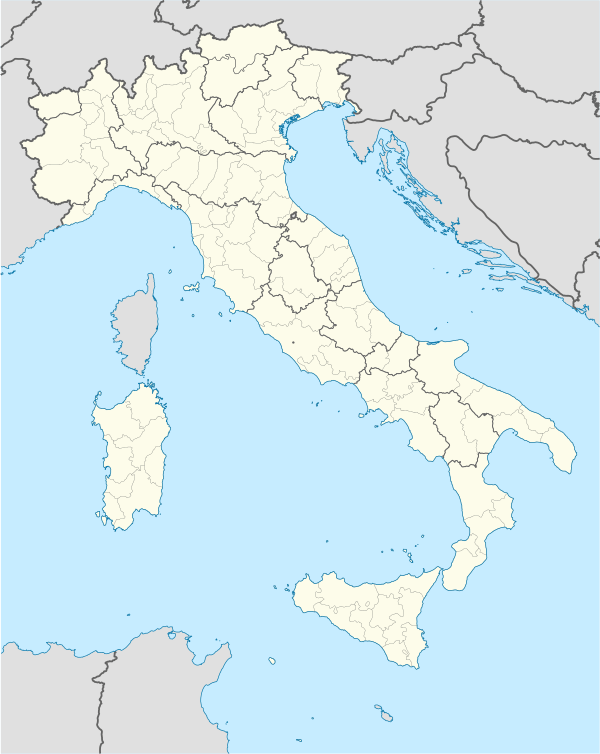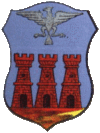Favignana
| Favignana | ||
|---|---|---|
| Comune | ||
| Comune di Favignana | ||
 | ||
| ||
 Favignana Location of Favignana in Italy | ||
| Coordinates: 37°56′N 12°20′E / 37.933°N 12.333°E | ||
| Country | Italy | |
| Region | Sicily | |
| Province | Trapani (TP) | |
| Frazioni | Levanzo, Marettimo | |
| Government | ||
| • Mayor | Lucio Antinoro | |
| Area | ||
| • Total | 37 km2 (14 sq mi) | |
| Elevation | 6 m (20 ft) | |
| Population (2007) | ||
| • Total | 4,383 | |
| • Density | 120/km2 (310/sq mi) | |
| Demonym | Favignanesi | |
| Time zone | CET (UTC+1) | |
| • Summer (DST) | CEST (UTC+2) | |
| Postal code | 91023 | |
| Dialing code | 0923 | |
| Website | Official website | |
Favignana is a comune including three islands (Favignana, Marettimo and Levanzo) of the Aegadian Islands, southern Italy. It is situated approximately 7 kilometres (4 miles) west of the coast of Sicily, between Trapani and Marsala, the coastal area where the Stagnone Lagoon and the international airport of Trapani, are sited.
The island is famous for its tuna fisheries and is now a popular tourist destination with frequent hydrofoil connections to the mainland.
History
In ancient times Favignana was called Aegusa, meaning "goat island" in Greek (Αιγούσα). The present name is derived from Favonio, an Italian name for the foehn wind. The Phoenicians established an outpost on the island as a stopping point on their trans-Mediterranean trading routes until the defeat of the carthaginian army during the First Punic War.
On 10 March 241 BC, a major naval battle was fought a short distance offshore between the two powers. Two hundred Roman ships under the consul Gaius Lutatius Catulus met and decisively defeated a much larger Carthaginian fleet of 400 ships, with the Romans sinking 120 Carthaginian vessels and taking 10,000 prisoners. So many dead Phoenicians washed ashore on the northeastern part of Favignana that the shoreline there acquired the name "Red Cove" (Cala Rossa) from the bloodshed (incorrect red from the red clay on the beach and not for the bloodshed). The Romans took possession of the island under the terms of the treaty that ended the war.
In the early Middle Ages, Favignana was captured by Arabs and was used as a base for the Islamic conquest of Sicily. The Normans subsequently took possession of the island, and built fortifications there from 1081. Under the Aragonese rulers of Sicily, Favignana and the other Aegadian Islands were hired out to Genoese merchants and in the 15th century the islands were granted to one Giovanni de Karissima, who adopted the grand title "Baron of Tuna".
The plentiful tuna fish found offshore were first exploited systematically under the Spanish from about the 17th century onwards. Facing severe financial problems from their ongoing wars, the Spanish sold the islands to the Marquis Pallavicino of Genoa in 1637. The Pallavicini substantially developed the economy of the island, prompting the establishment of the modern town of Favignana around the Castello San Giacomo. In 1874, the Pallavicino family sold the Aegadian Islands to Ignazio Florio, the son of a wealthy mainland industrialist, for two million liras. He invested heavily in Favignana and built a major tuna cannery on the island, bringing prosperity to many of the inhabitants. Calcarenite quarries were also opened with stone being exported to Tunisia and Libya.
The islanders had a much more difficult time during the 20th century. Favignana's economy slumped between the two World Wars and many inhabitants emigrated to the mainland and abroad. The tuna fishery also declined with the rise of factory fishing after World War II, but thanks to the Parodi Brothers (Mario, Giovanni Battista and Vittorio, but most of all the last two) who bought the factory after Florio family's troubles, the business of tuna fishing and the factory could work till the '80. Due to this business and to this family, welfare was guaranteed to almost all the old inhabitants of the island. However, the island's fortunes were turned around by the advent of tourism from the late 1960s onwards.
During WWII, American Forces under Gen. Patton drove the Axis forces from Sicily. Two American officers, Lt. Louis testa, and Capt. R.E. Gerard, were a two-man ‘expedition’ which ‘captured' three Italian Egadi Islands and 1027 prisoners. The officers went over from a Sicilian fishing boat, which they paid $3. They went ashore on Favigna Island and the Italian Lt. Colonel surrendered it along with Levanzo and Marittimo Islands and their garrisons.
Geography
Favignana is the largest of the three principal Egadi Islands, with a land area of 19.8 square kilometres (7.6 sq mi). The island is often described as having a "butterfly" shape. Favignana town is located on a narrow isthmus connecting the two "wings", which have quite different characteristics. The eastern half of the island is largely flat, while the western half is dominated by a chain of hills of which Monte Santa Caterina is the tallest at 314 metres (1,030 ft). It is topped by a fort, originally established by the Saracens and still in use by the Italian military (and closed to the public). A number of small islands are situated off the south coast of Favignana.
Main sights
The island is famous for its caves of calcarenite rock (locally known as "tufo") and the ancient fishing technique of tonnara, with the trapping and mattanza (massacre) of bluefin tuna. Because the island consists mainly of calcareous rocks, there are few beaches on the island; however, it is a popular site for scuba diving, snorkeling, and for day trips from nearby Trapani.
Further reading
| Wikimedia Commons has media related to Favignana. |
- Mattanza by Theresa Maggio (ISBN 0-14-100160-7), an American writer's account of the Favignana's springtime tonnara.
References
Newspaper article in the PM Daily, Thursday August 12, 1943 NYC
External links
- Website with history, suggestions and guides about Favignana
- Detailed information about Favignana and his history
